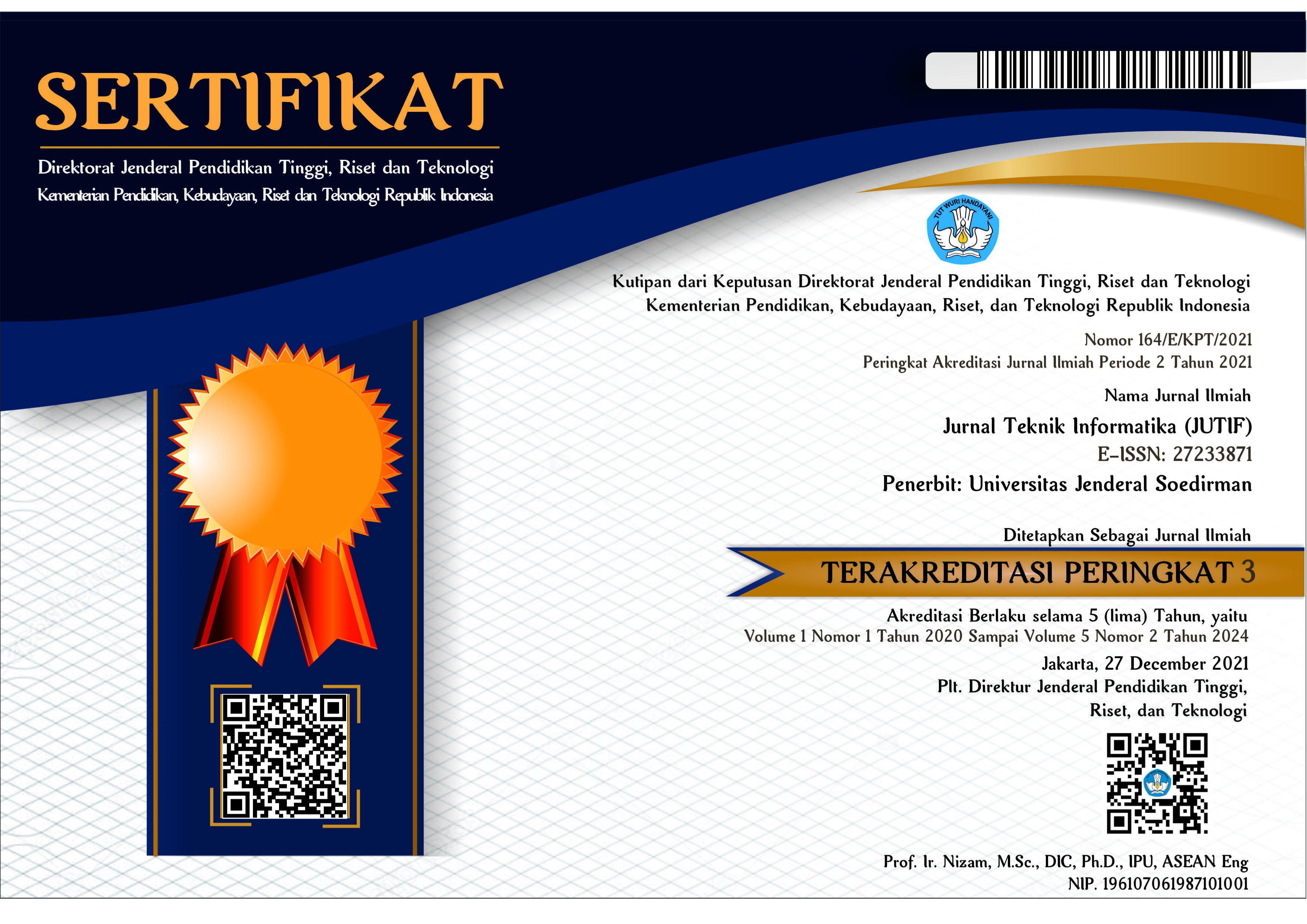MAKHRAJ ‘AIN PRONUNCIATION ERROR DETECTION USING MEL FREQUENCY CEPSTRAL COEFFICIENT AND MODIFIED VGG-16
DOI:
https://doi.org/10.52436/1.jutif.2023.4.1.419Keywords:
CNN, Hijaiyah, Makhraj, MFCCAbstract
Based on research conducted by the Institute of Qur'anic Sciences (IIQ) as many as 65% of Muslims in Indonesia are illiterate in the Qur'an. In previous studies, research was conducted on the detection of Arabic word pronunciation errors against non-natives using the Mel Frequency Cepstral Coefficient (MFCC) and Support Vector Machine (SVM) methods with a test result of 54.6%. Due to the low accuracy results in previous studies, this study aims to design and build a system that can correct the accuracy of the pronunciation of makhraj letter ‘ain with the method used is a combination of MFCC and Convolutional Neural Network (CNN) with a vgg-16 structure that has been modified. The dataset used is 1,600 voice recordings divided into two categories of the correct pronunciation of the letter ‘ain and incorrect pronunciation of the letter ‘ain and four variations of pronunciation with different vowels with a total data of 800 records in each category. This study conducted several experiments on variations of the CNN kernel. The results of the training model that produced the best accuracy in all variations were the training model on kernels 16, 32, 64 with a final accuracy rate of 100% for all variations with 96% accuracy validation. In the fathah variation, the validation accuracy is 94%. In the variation of dhommah and the variation of kasrah obtained a validation accuracy of 97%. Therefore, this study succeeded in distinguishing the sound of the pronunciation of the letter ‘ain with different vowels and measuring the accuracy of the pronunciation of the letter ‘ain. Implementing the modified vgg-16 produces high accuracy and validation values for each speech variation during the model train process.
Downloads
References
M. A. Prof. Dr. H. Muhammad Chirzin, Kearifan Al-Qur’an. Jakarta: PT Gramedia Pustaka Utama, 2020.
M. Oktapiani, “Tingkat Kecerdasan Spiritual Dan Kemampuan Menghafal Al-Qur’an,” Tahdzib Al-Akhlaq J. Pendidik. Islam, vol. 3, no. 1, hal. 95–108, 2020, doi: 10.34005/tahdzib.v3i1.861.
N. D. R. AGUSTIANA, “Implementasi Pembelajaran Menghafal Alqur’an Melalui Metode Tsami’ Dan Muroja’ah Di Pondok Pesantren Putri Raudhatul Musthofa Pundensari Rejotangan Tulungaggung,” IAIN Tulung Agung, 2019.
F. Aulia, “Hubungan Pemahaman Ilmu Tajwid dengan Kemampuan Membaca Al-Qur’an kelas V di MIN 1 Bandar Lampung.,” UIN RADEN INTAN LAMPUNG, 2020. [Daring]. Tersedia pada: http://dx.doi.org/10.1016/j.ndteint.2014.07.001%0Ahttps://doi.org/10.1016/j.ndteint.2017.12.003%0Ahttp://dx.doi.org/10.1016/j.matdes.2017.02.024
Viska Mutiawani, Maria Ulfa, dan Muslim, “KepoTajwid: Aplikasi Pembelajaran Ilmu Tajwid Berbasis Web Interaktif,” IJAI Indones. J. Appl. Informatics, 2018.
Kuswandi, “Korelasi Pemahaman Ilmu Tajwid dengan Kemampuan Membaca Alqur’an Santri Pondok Pesantren ’Ainul Ulum Pulung Ponorogo Tahun Ajaran 2017-2018,” IAIN PONOROGO, 2018.
V. M. - STMIK Nusa Mandiri Jakarta, H. M. N. - AMIK BSI Purwokerto, dan W. R. - AMIK BSI Purwokerto, “Aplikasi Pembelajaran Ilmu Tajwid Berbasis Android,” Evolusi J. Sains dan Manaj., vol. 6, no. 1, hal. 91–100, 2018, doi: 10.31294/evolusi.v6i1.3586.
Suci Shofia, Tajwid for Children. Bandung, 2018.
Khuriyatul Wafiah, “Hubungan Antara Penguasaan Ilmu Tajwid Dengan Kemampuan Membaca Dan Menghafal Al-Qur’an Surah Pendek Santri Putri Kelas Vii Pondok Modern Darul Hikmah Tawangsari Tulungangung,” IAIN Tulung Agung, 2019.
A. Febrianto, J. T. Informatika, dan A. Reality, “View of Penggunaan Teknologi Augmented Reality Dalam Mempelajari Ilmu Tajwid Use Of Augmented Reality Technology In Studying Tajwid Science Using Augmented Reality Technology In Studying Tajwid Science,” vol. 7, no. 1, hal. 83–90, 2018.
R. J. Rosyanafi, “Pengaruh Media Jigsaw Puzzle Terhadap Minat Belajar Huruf Hijaiyah Anak Usia Dini,” Ijaz Arab. J. Arab. Learn., vol. 1, no. 1, 2018, doi: 10.18860/ijazarabi.v1i1.5016.
S. Muthmainnah dan I. Nuramaliah, “Analisis Kesalahan Pelafalan Bunyi Huruf 1 Hijaiyyah berdasarkan Makhorijul huruf dalam Membaca Teks Dialog Bahasa Arab Siswa Kelas X SMA Muhammadiyah Limbung,” hal. 1–10, 2019.
E. Musdzalifah, “Materi Ilmu Tajwid Dalam Kitab Terjemah Matan Jazariyah Karya Syekh Muhammad Bin Muhammad Ibn Al Jazari Dan Implementasinya Dalam Mata Pelajaran Qur’an Hadits Kelas Vii Madrasah Tsanawiyah,” no. November, 2020.
SAEFUL ANAS, “Kajian Ilmu Tajwid pada Kitab Matan Al-Muqaddimah Al-Jazariyah karya Ibnu Jazari dan Relevansinya dengan Bahan Ajar Al-Qur’an Hadits Kelas VIII Madrasah Tsanawiyah,” IAIN Kudus, 2020.
A. A. Al Halim dan Wida Nurul ’Azizah, “Upaya Peningkatan Kemampuan Membaca Al-Qur’an Melalui Pengenalan Huruf Hijaiyah Menggunakan Metode Qo’idah Baghdadiyah Ma’a Juz ‘Amma (Turutan) Di Kelas 1a Mi Ma’arif Nu 01 Tritihkulon Tahun Pelajaran 2015/2016,” Tawadhu, vol. 2, no. 1, hal. 490, 2018.
D. Ratnasri, “Problematics of the Qur ’ an Learning in the Industry Era,” vol. 6, no. 1, hal. 72–92, 2020.
A. Ashar, M. S. Bhatti, dan U. Mushtaq, “Speaker Identification Using a Hybrid CNN-MFCC Approach,” 2020 Int. Conf. Emerg. Trends Smart Technol. ICETST 2020, 2020, doi: 10.1109/ICETST49965.2020.9080730.
R. T. Handayanto dan H. Herlawati, “Prediksi Kelas Jamak dengan Deep Learning Berbasis Graphics Processing Units,” J. Kaji. Ilm., vol. 20, no. 1, hal. 67–76, 2020, doi: 10.31599/jki.v20i1.71.
H. Heriyanto, S. Hartati, dan A. E. Putra, “Ekstraksi Ciri Mel Frequency Cepstral Coefficient (Mfcc) Dan Rerata Coefficient Untuk Pengecekan Bacaan Al-Qur’an,” Telematika, vol. 15, no. 2, hal. 99, 2018, doi: 10.31315/telematika.v15i2.3123.
R. Magdalena et al., “Convolutional Neural Network for Anemia Detection Based on Conjunctiva Palpebral Images,” J. Tek. Inform., vol. 3, no. 2, hal. 349–354, 2022, [Daring]. Tersedia pada: http://jutif.if.unsoed.ac.id/index.php/jurnal/article/view/197




























